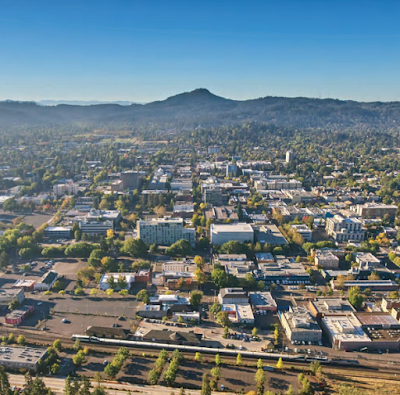Eugene (image from the Community Design Handbook)
The presence of real public spaces is important to the existence of any civil society. So too is differentiating those spaces so they are as unique, context-specific, attractive, and meaningful as possible. Investing intellectual and monetary capital in the public realm—such as in downtown Eugene where we as a community exercise our social and civic functions—is crucial. Regardless of who makes that investment, the public realm should always remain free to use, accessible, and welcoming to people from all walks of life.
Maximizing the public realm as a shared interest is important because it is our public spaces that most effectively differentiate here from everywhere and nowhere. In Eugene this means recognizing what makes our city’s cultural, physical, and historical context unique. It means countering the prevalent banality of Eugene’s public spaces. It means stressing the importance of physical structure and identity—the vividness of unique elements and conversely a grasp of the whole. It also means following principles of good urban form to help ensure the development of memorable, attractive public places.
A characteristic of good public spaces is no one is excluded from using them. While this isn’t always the case for the buildings that shape those public spaces, no one argues buildings don’t contribute toward the success or failure of the urban settings of which they’re a part. People recognize good public spaces when they see and experience them. Likewise, they immediately know and pointedly avoid uncomfortable and unattractive places.
We all bear the costs of negative externalities associated with poorly designed projects. These can include alienating streetscapes and the undesirable behavior that often accompanies them. Good design can make a difference. Enlightened municipalities are rewriting their land use codes to disincentivize urban sprawl and individuals’ reliance upon the automobile, while encouraging active sidewalks, walkable neighborhoods, and vibrant mixed-use developments.
The consequences of negative externalities are one reason why form-based codes are finding increased acceptance in communities across the county. Unlike conventional zoning, form-based codes address the relationship between public and private spaces by prescribing the interaction between streets and buildings in terms of form, scale, and massing. For example, a form-based code typically regulates minimum as well as maximum building heights and building setback requirements, dictates building orientation, and specifies where parking areas should be located. Advocates for form-based codes cite their ease of use. Compared to conventional zoning documents, they are typically shorter and organized for visual access and readability. Their stated purpose is the shaping of a high-quality urban realm, a presumed public good.
The City of Eugene worked with key stakeholders including local businesses, the University of Oregon, and surrounding residents to develop a form-based code for the Walnut Station node along Franklin Boulevard. Implemented as the S-WS Walnut Station Special Area Zone, the code retains aspects of a conventional land use code (such as the prohibition or segregation of certain uses), while aspiring to achieve a predictable built environment comprising quality public spaces. Time will tell if it is a success.
Form-based codes do have their detractors. Critics argue form-based codes distort real estate markets, undermine the order of a spontaneous economy, and generally are representative of public-sector meddling in the rightful business of the private sector. They do constitute a form of taxation, imposing constraints on private goods. And from the perspective of some design professionals, form-based codes are overly prescriptive, sometimes fail to address the existing community context and character, and leave too little room for design discretion and creativity.
The critics’ concerns have merit, but they don’t acknowledge the public and private benefits form-based codes often yield. The predictable physical results of form-based codes are good for business and in the public interest. That said, it’s prudent to be wary of imperfect planning tools shaped by imperfect, albeit well-intentioned, human beings. The dynamics of development and the factors that contribute to achieving a livable community will always be far too complex to effectively and flawlessly codify and regulate. Regardless, prescribing the type of development—as opposed to doing nothing at all—is necessary if we want the right outcome for our community.
An excerpt from the Walnut Station form-based code.
Town Square rendering.
Fundamentally, Moore argued paying for the public life is necessary to avoid the loss of differentiated places and the emergence of “gray no-places and the inundation of the places of special significance.” He saw this responsibility extending to both the public agencies and private developers responsible for so much of the built environment that shapes society’s shared spaces. Though more than half a century has passed since he expressed his views on the subject, his words remain relevant today.
Even dyed-in-the-wool free marketeers can agree operating within a communal vision and legal framework is potentially profitable. Good public spaces repay the investments in them—both private and public—many times over by abetting economic and cultural vitality. Developers enjoy the rewards of their commitment to a shared community vision through revenues generated by the desirability of the places they’ve helped shape. Local governments win too as the tax base swells. This is an implicit social contract, one necessary if our public spaces are to thrive.
Paying for the public life is not a zero-sum proposition. Everyone wins if we all invest in the betterment of our public spaces.



No comments:
Post a Comment